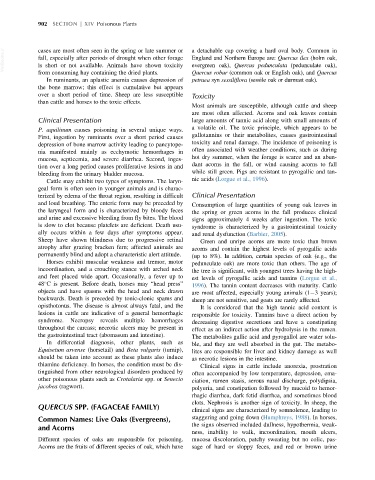Page 950 - Veterinary Toxicology, Basic and Clinical Principles, 3rd Edition
P. 950
902 SECTION | XIV Poisonous Plants
VetBooks.ir cases are most often seen in the spring or late summer or a detachable cap covering a hard oval body. Common in
England and Northern Europe are: Quercus ilex (holm oak,
fall, especially after periods of drought when other forage
evergreen oak), Quercus pedunculata (pedunculate oak),
is short or not available. Animals have shown toxicity
from consuming hay containing the dried plants. Quercus robur (common oak or English oak), and Quercus
In ruminants, an aplastic anemia causes depression of petraea syn sessiliflora (sessile oak or durmast oak).
the bone marrow; this effect is cumulative but appears
over a short period of time. Sheep are less susceptible Toxicity
than cattle and horses to the toxic effects.
Most animals are susceptible, although cattle and sheep
are most often affected. Acorns and oak leaves contain
Clinical Presentation large amounts of tannic acid along with small amounts of
P. aquilinum causes poisoning in several unique ways. a volatile oil. The toxic principle, which appears to be
First, ingestion by ruminants over a short period causes gallotannins or their metabolites, causes gastrointestinal
toxicity and renal damage. The incidence of poisoning is
depression of bone marrow activity leading to pancytope-
often associated with weather conditions, such as during
nia manifested mainly as ecchymotic hemorrhages in
hot dry summer, when the forage is scarce and an abun-
mucosa, septicemia, and severe diarrhea. Second, inges-
dant acorns in the fall, or wind causing acorns to fall
tion over a long period causes proliferative lesions in and
while still green. Pigs are resistant to pyrogallic and tan-
bleeding from the urinary bladder mucosa.
nic acids (Lorgue et al., 1996).
Cattle may exhibit two types of symptoms. The laryn-
geal form is often seen in younger animals and is charac-
terized by edema of the throat region, resulting in difficult Clinical Presentation
and loud breathing. The enteric form may be preceded by Consumption of large quantities of young oak leaves in
the laryngeal form and is characterized by bloody feces the spring or green acorns in the fall produces clinical
and urine and excessive bleeding from fly bites. The blood signs approximately 4 weeks after ingestion. The toxic
is slow to clot because platelets are deficient. Death usu- syndrome is characterized by a gastrointestinal toxicity
ally occurs within a few days after symptoms appear. and renal dysfunction (Barbier, 2005).
Sheep have shown blindness due to progressive retinal Green and unripe acorns are more toxic than brown
atrophy after grazing bracken fern; affected animals are acorns and contain the highest levels of pyrogallic acids
permanently blind and adopt a characteristic alert attitude. (up to 8%). In addition, certain species of oak (e.g., the
Horses exhibit muscular weakness and tremor, motor pedunculate oak) are more toxic than others. The age of
incoordination, and a crouching stance with arched neck the tree is significant, with youngest trees having the high-
and feet placed wide apart. Occasionally, a fever up to est levels of pyrogallic acids and tannins (Lorgue et al.,
48 C is present. Before death, horses may “head press” 1996). The tannin content decreases with maturity. Cattle
objects and have spasms with the head and neck drawn are most affected, especially young animals (1 3years);
backwards. Death is preceded by tonic-clonic spams and sheep are not sensitive, and goats are rarely affected.
opisthotonus. The disease is almost always fatal, and the It is considered that the high tannic acid content is
lesions in cattle are indicative of a general hemorrhagic responsible for toxicity. Tannins have a direct action by
syndrome. Necropsy reveals multiple hemorrhages decreasing digestive secretions and have a constipating
throughout the carcass; necrotic ulcers may be present in effect as an indirect action after hydrolysis in the rumen.
the gastrointestinal tract (abomasum and intestine). The metabolites gallic acid and pyrogallol are water solu-
In differential diagnosis, other plants, such as ble, and they are well absorbed in the gut. The metabo-
Equisetum arvense (horsetail) and Beta vulgaris (turnip), lites are responsible for liver and kidney damage as well
should be taken into account as these plants also induce as necrotic lesions in the intestine.
thiamine deficiency. In horses, the condition must be dis- Clinical signs in cattle include anorexia, prostration
tinguished from other neurological disorders produced by often accompanied by low temperature, depression, ema-
other poisonous plants such as Crotalaria spp. or Senecio ciation, rumen stasis, serous nasal discharge, polydipsia,
jacobea (ragwort). polyuria, and constipation followed by mucoid to hemor-
rhagic diarrhea, dark fetid diarrhea, and sometimes blood
clots. Nephrosis is another sign of toxicity. In sheep, the
QUERCUS SPP. (FAGACEAE FAMILY)
clinical signs are characterized by somnolence, leading to
Common Names: Live Oaks (Evergreens), staggering and going down (Humphreys, 1988). In horses,
the signs observed included dullness, hypothermia, weak-
and Acorns
ness, inability to walk, incoordination, mouth ulcers,
Different species of oaks are responsible for poisoning. mucosa discoloration, patchy sweating but no colic, pas-
Acorns are the fruits of different species of oak, which have sage of hard or sloppy feces, and red or brown urine

